12
With the advancement of technology, wireless power transfer has received more and more attention. And as a medium-range wireless power transfer technology with higher power and larger transmission efficiency, magnetic coupling resonant wireless power transfer (MCR-WPT) has become a research hotspot.
Wireless power transfer using magnetic coupled resonant circuits
Catalog
I Basic Principle | 1.1 Basic Structure |
1.2 Working Principle | |
1.3 Theoretical Basis | |
II Key Technologies | 2.1 High Frequency Power Transformation Technology |
2.2 Resonance Compensation Technology | |
III Focus of Research | 3.1 Frequency Splitting Problem |
3.2 Frequency Consistency | |
3.3 System Structure and Transmission Path | |
3.4 Operating Frequency Range and Optimal Transmission Distance | |
3.5 Interference Problems | |
IV Application Prospects | |
I Basic Principle
1.1 Basic Structure
At present, most of the MCR-WPT systems adopt the structure shown in Figure 1 two-coil structure, and Figure 2 is its equivalent circuit. The power transmission system includes two parts, an power emitting end and an power receiving end.
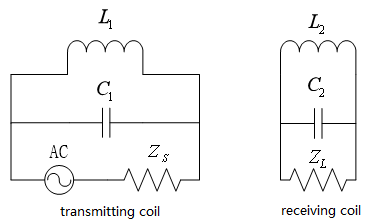
Figure 1. Two-coil Structure
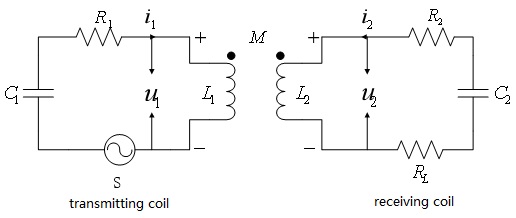
Figure 2. Equivalent Circuit
1.2 Working Principle
The wire-wound transmitting coil is a air-core inductance coil L, L and a resonant capacitor are connected in parallel to form a resonator. The energy contained in the resonator is free to oscillate in space between the electric field and the magnetic field at its self-resonant frequency, creating a time-varying magnetic field with coil as center and air as the transmission medium.
The receiving end is a resonator formed by one receiving coil connected in parallel with one capacitor, whose natural resonant frequency is the same as the transmitting frequency. Its induced magnetic field energy also oscillates freely in space at self-resonant frequency between the electric field and the magnetic field, and at the same time, there is a constant exchange of magnetic field energy between the two resonators. That is, the two resonators constitute a coupled resonance system.
1.3 Theoretical Basis
At present, the commonly-used MCR-WPT system model includes a coupled-mode theoretical model and a mutual inductance equivalent circuit model.
Coupled-mode Theoretical Model
MIT first used coupled-mode theory to explain resonant wireless power transfer.
Taking the two-coil transmission system of Figure 1 as an example, the coupled-mode formula of the system can be expressed as follows:
 (1)
(1)
In the formula, ![]() are respectively the normal mode of the transmitting coil and the receiving coil, and
are respectively the normal mode of the transmitting coil and the receiving coil, and ![]() are respectively the attenuation constant of the transmitting coil, the receiving coil, and load.
are respectively the attenuation constant of the transmitting coil, the receiving coil, and load. ![]() are the coupling coefficients of the two coils,
are the coupling coefficients of the two coils, ![]() are respectively the resonant frequencies of the transmitting coil and the receiving coil, s is the driver entry introduced by the source.
are respectively the resonant frequencies of the transmitting coil and the receiving coil, s is the driver entry introduced by the source.
Adjusting the power of the driving source allows the resonant system to enter a stable state. When the power transmitted in the system by the excitation source is equal to the power consumed by the load and the coil itself, the total energy in the entire system remains unchanged. The transmission efficiency formula of the system is as follows:
 (2)
(2)
Mutual inductance equivalent circuit model
For the Figure1, according to the following equation based on Kirchhoff's voltage law:
 (3)
(3)
among them,
 (4)
(4)
When the system is in resonance, the transmission efficiency formula of the system is as follows:
 (5)
(5)
In the formula(5): Q is the quality factor of the resonator  .
.
II Key Technologies of MCR-WPT
2.1 High Frequency Power Transformation Technology
In the MCR-WPT system, high-frequency power transformation mainly undertakes the task of providing a stable high-frequency alternating excitation current for the energy guide rail that generates the power magnetic field. After the transformation, AC power source of 50Hz power frequency will provide a high -frequency sinusoidal current from 10kHz to 100kHz to the energy emission guide rail. As the key link of high-frequency electromagnetic energy transformation, its working efficiency, stability and reliability directly determine the overall performance of the system. In general high-power applications, there are some requirements for this link :
1. In order to ensure the stability of power transmission, the frequency and amplitude of the exciting current in energy emission guide rail should be constant. The current should also have strong robustness to load change and parameter drift;
2. In order to improve the overall efficiency and reliability of the system, the loss and voltage (current) transient rate of the transformation link should be controlled within a lower-level range;
3. In order to reduce the high-frequency loss of the energy emission guide rail and the electromagnetic interference to the surrounding environment, the output high-frequency current should be a sinusoidal current with a lower waveform distortion factor;
4. In order to make the system adapt to the power requirements of different loads, the transformation link should have certain power adjustment capability.
2.2 Resonance Compensation Technology
In the MCR-WPT system, in order to improve the power transmission capability and reduce the requirements of the volt-ampere level of the input power supply, a compensation capacitor is added to the primary coil and the secondary coil of the system to make the system working in a resonant state. According to the difference of the connection relation between the primary coil and the primary compensation capacitor and between the secondary coil and the secondary compensation capacitor, there are four basic topology structures as shown in Figure 3.
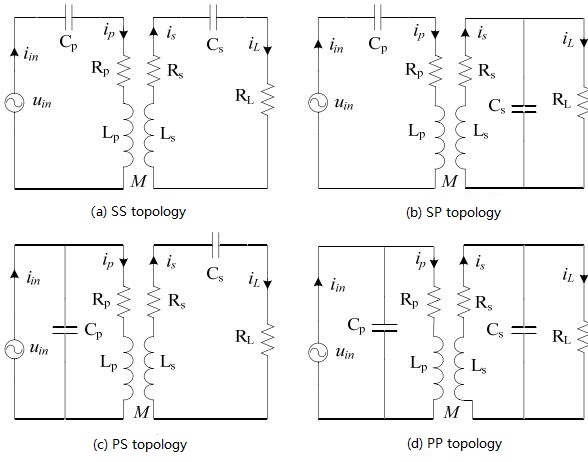
Figure 3. Four Basic Topologies of the ICPT System
In this figure, S represents series compensation, which means the compensation capacitor and the coil inductor are connected in series. P is the parallel compensation, which indicates the compensation capacitor and the inductor are connected in parallel. Lp and Ls are the primary and secondary inductors respectively, Cp and Cs are the primary and secondary tuning capacitors, Rp and Rs are the internal resistances of the primary and secondary coils, and RL is the load resistance. Besides, M is the mutual inductance between the primary and secondary inductors, uin and iin are the input voltage and current, and ip and is are the primary and secondary resonant currents.
III Focus of Research
3.1 Frequency Splitting Problem
In MCR-WPT, there are often more than two resonant frequencies or multiple current (voltage) peaks, which is frequency splitting problem. Especially in close-range transmission, the multi-peak phenomenon is more prominent, which affects system transmission efficiency.
Some researchers proposed to suppress the frequency splitting phenomenon by increasing the number of relay resonant coils, which greatly improved the transmission efficiency, but the structure is difficult to achieve.
Studying from the coupled-mode model, some people think that the distance affects the phase of transmission system. When the resonant frequency is lower, the energy system is in the same phase, and if the resonant frequency becomes higher, the transmission system is in the reverse state, which explains the change in the number of resonance peaks.
Many researchers have done a lot of successful work on controlling parameters and structures, such as adjusting the resonance frequency, increasing the matching network, etc., which achieved better transmission effects.
3.2 Frequency Consistency
Efficient MCR-WPT is based on the consistency of resonance frequency in the system. It is very important to ensure frequency consistency and frequency consistency control at different distances and different working conditions, otherwise the power, transmission efficiency and the performance of the system will decrease. In order to facilitate the adjustment of the system frequency, some people proposed to adjust the transmission peak by increasing the relay level coils. Other researchers tried to use circuit theory to analyze the transmission system with relay resonant coils. By solving the eigenvalues of the system matrix, a new resonant frequency ω is obtained. However, these theories and methods need to be further verified in future research.
3.3 System Structure and Transmission Path
The study of system structure and transmission path mainly includes the problem of the logarithm and the center line alignment of the coil, single transmission-single reception, single transmission-multiple reception and multiple transmission-single reception. At present, many scholars have carried out a number of studies on system structure and transmission path, and the related results obtained are:
1. MCR-WPT is not very sensitive to the direction of the transmitting end and the receiving end;
2. If one transmitting coil and multiple receiving coils are adopted, the overall transmission efficiency is higher than the one-to-one structure;
3. When the receiving coil reaches a certain number, and if the coil is further increased, the overall efficiency will drop sharply.
Therefore, the system structure should be carefully and reasonably selected, and further factors such as auto adaptive tracking adjustment of the frequency should also be further studied.
3.4 Operating Frequency Range and Optimal Transmission Distance
The main mechanism of wireless power transfer comes from the mechanism and experiment proposed by Nikola-Teasla in the 19th century.
In order to realize the transmission of electric energy, the frequency f is related to the diameter of transmission coil d and the transmission distance D. For example, if f = 10 MHz and D = 30 cm, then d = 30/(2π) = 4.78 cm. The diameter of the transmitting coil has a very complicated relationship with the efficiency, the operating frequency, and the width of the coil wire. Considering the the integrated factor y(Q, Γ, x), in which Q is coil value, Γ is the loss, and x is the diameter ratio of the transmission and receiving coil , the diameter of the transmitting coil is expressed as:
 (6)
(6)
Where d is the distance between the transmitting and receiving coils, f is the resonant frequency, d1 is the diameter of coil wire, and k is the coupling coefficient. Seen from this equation, we could know that in the process of energy transmission, the operating frequency is different under different conditions, but there is an optimal receiving area. Besides, the power and distance of the antenna also need to be precisely designed.
3.5 Interference Problems
The MCR-WPT system works in the electromagnetic environment of various electrical equipment. Compared with other power transfer systems, it is easily interfered by the active interference of external magnetic fields. And any component that can sense the magnetic field will become loads that create passive interference, which causes the frequency drift of the system transmission.
Various experimental studies on the effects of active interference and passive interference on the transmission system have been carried out. The results is that whether is active or passive interference, the energy transmission system is very sensitive to the frequency of the interference source. The closer the interference source frequency is to the resonant frequency of the transmission system, the greater the impact is on the transmission system. For example, if high-frequency harmonic of the power electronic equipment reach the system resonance frequency, it will cause strong interference to the energy transmission system.
IV Application Prospects
MCR-WPT technology is expected to have broad application prospects, at least in the following seven aspects:
1. It can be applied in small home appliances, personal computers, networks, etc, which can greatly reduce the wires, plugs, and switches in homes and offices.
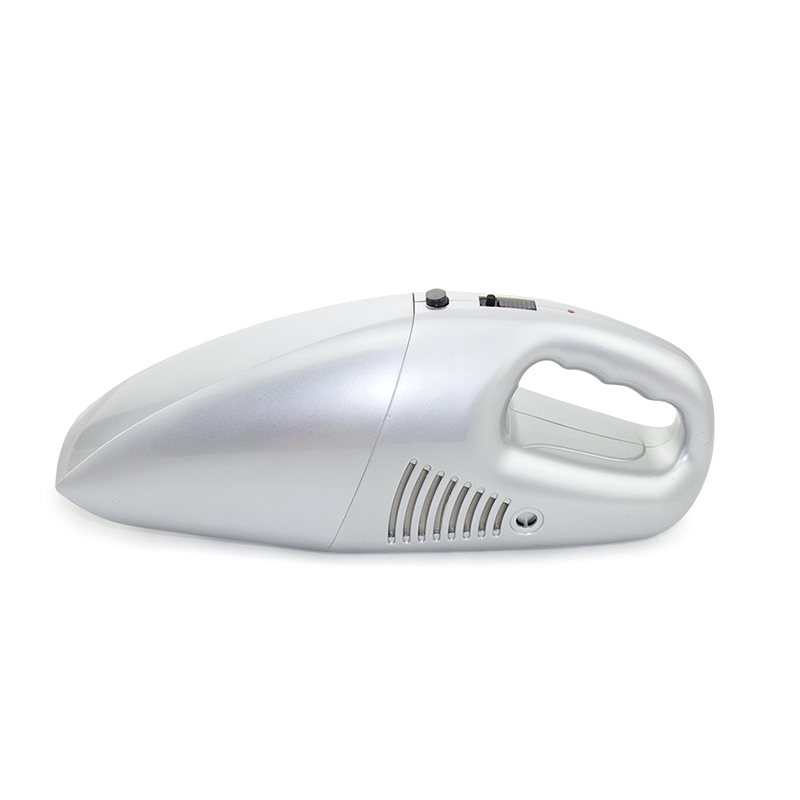
Wireless Charging Vacuum Cleaner
2. Electric vehicles are the main application areas of wireless energy transfer systems, which can realize wireless charging of electric vehicles and charging while walking;
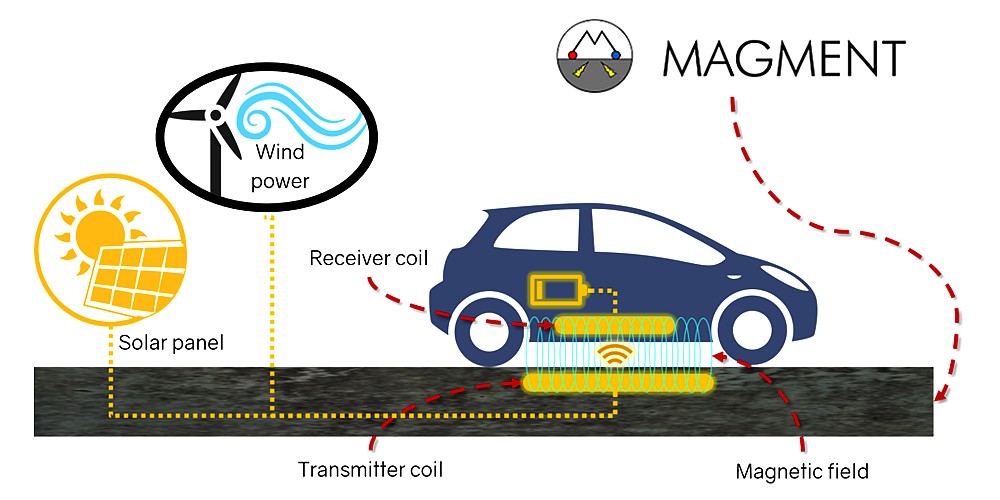
Wireless Electric Vehicles Charging
3. New energy generation systems and smart grids;
4. Mobile small robots, wireless sensor networks and radio frequency identification technology (RFID);
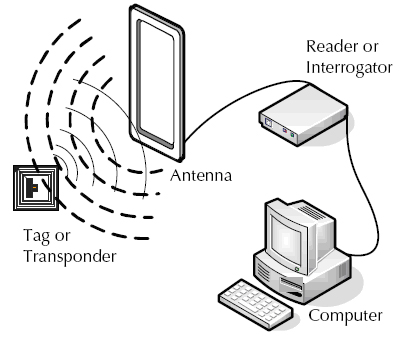
How does RFID Works?
5. Oilfield, mines, underwater operations, aerospace and other special fields.
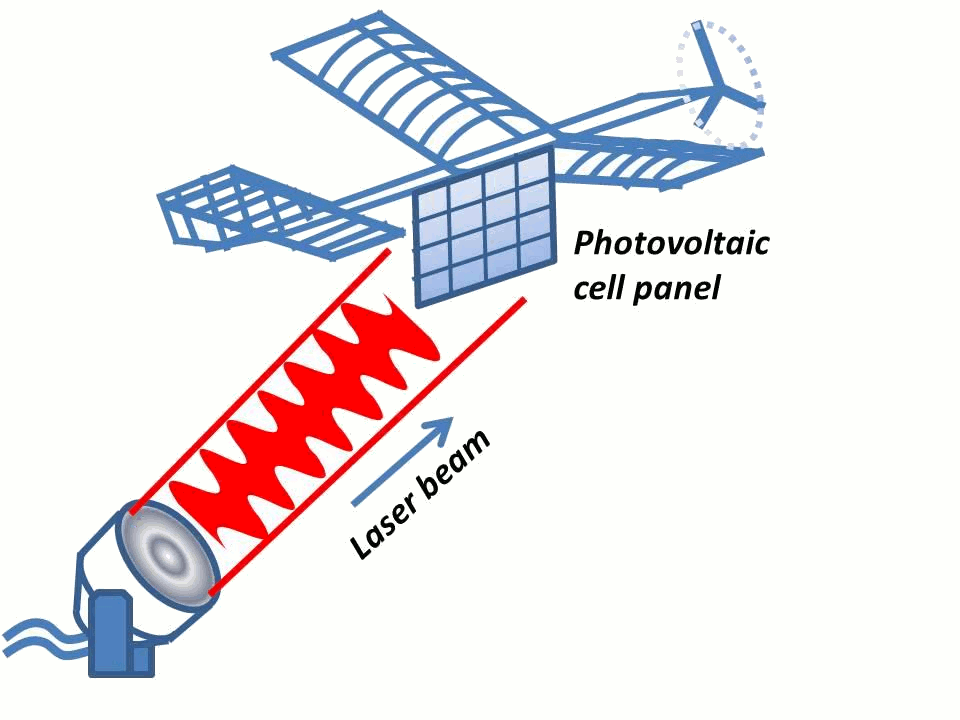
Wireless Charging in Aerospace
Since there is no excessive consideration of cost and transmission efficiency in military, wireless energy transfer system will be likely to developed first in military equipment and command systems, and then expanded into the civilian field.
You May Also Like:
Features, Developemnt Trends and Disadvantages of Wireless Power Transfer
Parameters, Classifications and Applications of Light Emitting Diode(LED)
Parameters, Identification and Applications of Zener Diode
Versions, Development Platforms, and Installation Sequence of Device Driver
Ordering & Quality
| Photo | Mfr. Part # | Company | Description | Package | Qty |
|
RB400DT146 | Company:Rohm Semiconductor | Remark:DIODE SCHOTTKY 40V 500MA SMD3 | Package:TO-236-3, SC-59, SOT-23-3 |
RB400DT146 Datasheet |
In Stock:9266 Inquiry |
Inquiry |
|
MC908QB4CDWE | Company:NXP | Remark:IC MCU 8BIT 4KB FLASH 16SOIC | Package:16-SOIC (0.295", 7.50mm Width) |
MC908QB4CDWE Datasheet |
In Stock:3816 Inquiry |
Inquiry |
|
MRF18060B | Company:MOT | Remark: | Package:SMD |
MRF18060B Datasheet |
In Stock:71 Inquiry |
Inquiry |
|
MC9S12GC64MFUE | Company:NXP | Remark:IC MCU 16BIT 64KB FLASH 80QFP | Package:80-QFP |
MC9S12GC64MFUE Datasheet |
In Stock:4926 Inquiry |
Inquiry |
|
MAX14515EWA+T | Company:Maxim Integrated | Remark:IC LENS DVR SMALL LIQUID 8-WLP | Package:8-WFBGA, WLCSP |
MAX14515EWA+T Datasheet |
In Stock:9184 Inquiry |
Inquiry |
|
MR82C54 | Company:NTERSIL | Remark: | Package:CLCC |
MR82C54 Datasheet |
In Stock:455 Inquiry |
Inquiry |
|
XC3S50A-4VQG100C | Company:Xilinx | Remark:IC FPGA 68 I/O 100VQFP | Package:100-TQFP |
XC3S50A-4VQG100C Datasheet |
In Stock:8618 Inquiry |
Inquiry |
|
SLB 9635 TT1.2 FW3.17 | Company:Infineon Technologies | Remark:IC SPECIALIZED | Package: |
SLB 9635 TT1.2 FW3.17 Datasheet |
In Stock:10854 Inquiry |
Inquiry |
|
CY62157DV30LL-55ZSXI | Company:Cypress Semiconductor Corp | Remark:IC SRAM 8MBIT 55NS 44TSOP | Package:44-TSOP (0.400", 10.16mm Width) |
CY62157DV30LL-55ZSXI Datasheet |
In Stock:1200 Inquiry |
Inquiry |
|
TMS320DM8127SCYED3 | Company:Texas Instruments | Remark:IC DGTL MEDIA PROCESSOR | Package:684-BFBGA, FCBGA |
TMS320DM8127SCYED3 Datasheet |
In Stock:433 Inquiry |
Inquiry |